Rigid connection for the mixer: device, pros and cons + installation features
Turning on the water from the tap has long become a common convenience. Therefore, the average person does not think about a complex system of plumbing fixtures.They are only interested in the quality of its work and water. But you will need special skills to install, maintain and select many components.
For example, to supply water to the kitchen, you need distribution pipes, a flexible or rigid connection for the mixer, and the combination tap itself. These components have many varieties and installation schemes.
In this material we will tell you what rigid eyeliner is, in what cases it is used and we will reveal some of the subtleties of its installation.
The content of the article:
What is eyeliner and where is it used?
After distributing water supply pipes around the site, you need to connect plumbing fixtures to them. This includes taps that shut off the water supply to the device if replacement/repair is necessary, and faucets that supply water to showers, bidets, urinals, water heaters, washing machines, dishwashers and other devices.
Since they usually do not have the ability to connect directly to the central water supply system, an additional element is used for connection - a liner. It ensures contact between the pipes and the mixer and meets the same strength requirements.
The connection pipes are called connecting metal pipes, if they are rigid, or metal and rubber hoses with braiding, if they are flexible.At the ends of these connectors there is a thread or fitting with a union nut, with the help of which they are secured to the faucet and water socket.

It is used not only in household plumbing, but also in industry to connect the hydraulics of complex equipment, in various transport equipment, and to connect gas pipelines to each other and equipment.
General structure and principle of operation
Depending on the type, plumbing connections may vary slightly in design.
Its main components include:
- metal tube or rubber hose with braid;
- union nut with an o-ring - used to tighten connections;
- union – a metal pipe that connects the tube and the mixer;
- nipple – is attached to the tube and has a movable connection with a union nut.
The fittings are located on both sides of the liner and are fixed to it by crimping using a crimp sleeve or welding. For connection, the fitting has an external thread and a rubber sealing washer.
For installation on a fitting with an external thread, a union nut is used, which, when tightened, provides a tight connection with the nipple at the end of the connection. An O-ring is also installed between the nipple and the union nut.
Since the nut rotates independently of the tube, the latter remains stationary when tightened. Therefore, installation must be done in the correct sequence.

Depending on the type, the liner can withstand pressures of up to 50 Bar and temperatures of up to 150 °C, which is more than enough for a hot water supply system. After all, according to GOST, working pressure in water supply pipes apartments should be 4 bar.
Main types of eyeliner
To install a faucet in a kitchen or bathroom, any type of this connection is technically suitable. But each of them has its own characteristics, which will be an advantage in some situations and a disadvantage in others.
How to choose a connection option?
The main evaluation criteria when choosing are the following:
- Reliability and service life. These are the most important parameters, but sometimes the result can be affected by the urgency of execution and the price of components, so for a while you can limit yourself to a flexible rubber braided hose instead of durable metal pipes.
- Ease of installation. If you install it yourself and lack the necessary skills, this can be critical. The situation may be aggravated by the inaccessible location of communications.
- Type of design. In some cases, the location of the plumbing allows you to install only flexible hoses.
- Quality and properties of nodes connections. They must match the fastenings of the already installed water supply system, so as not to use additional adapters.
It is worth deciding in advance on the position of the mixer and ease of access to the plumbing system underneath for further maintenance.

It is advisable to take into account the possibility of replacing one type of liner with another when installing a mixer and water socket. To do this, it should be brought to a distance closer than 50 cm.
Flexible inlet design
The most inexpensive option for this type of plumbing product is flexible. It is widespread and is sold in any store.
The low price is due to the fairly simple device and materials. Structurally, it is a rubber hose with a thread braid and connecting elements at the ends.
Main components of flexible liner:
- hose;
- braid;
- crimp pressable metal sleeve;
- rubber gaskets for sealing the connection;
- nipple and nut, which is used to connect to the elements of the plumbing system;
- union.
The nipple is securely fixed in the tube and is movably connected to a union nut, which rotates independently of it. An O-ring is installed between them.
On the other side of the tube there is usually a fitting, which also has O-rings. But the thread in it is located outside. There are fittings without threads; they are connected using a pressure plate on the body - a petal.
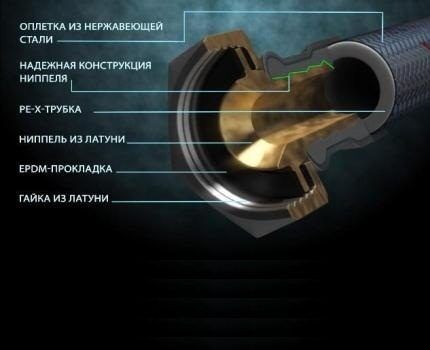
The main advantages of such an eyeliner are considered to be low cost and mobility.They can connect the mixer to the water supply in any relative position. The installation itself is quite comfortable, since you can change the position of the hose to a more convenient one.
It is made from non-toxic rubber or high-quality rubber. The braid is made from threads of steel, galvanized iron or aluminum. The most reliable and durable is the first material, which, with high-quality braiding, can withstand pressure of up to 10 atmospheres.
Disadvantages include susceptibility to water hammer and poor-quality rubber hoses in budget products.
Bellows hose for faucet
This water supply system is made of stainless steel and has a corrugated surface, which is created by rolling up a metal strip, the seams of which are welded using argon welding. The connecting elements are union nuts made of brass.
Key advantages of bellows supply:
- Withstands temperatures up to 250 °C and its changes for a long time and without harm.
- Wear-resistant.
- Resistant to corrosion.
In addition to all this, it allows for fairly simple and comfortable installation. Much more reliable and durable than flexible braided hoses, although they themselves tend to bend and retain their shape.
You can read more about the bellows liner for the mixer and the intricacies of its installation in this material.
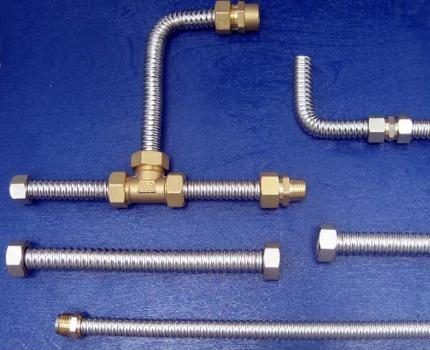
Rigid liner design
The name characterizes this eyeliner. Its main quality is rigidity. With this design, the mixer is fixedly mounted on the pipes.
For any repair, you will have to disconnect the liner. This is quite inconvenient, because in its flexible design you can still perform some moving manipulations with the crane.
Externally, chrome or copper pipes may look more aesthetically pleasing than the dangling wires of flexible hoses, but in most cases this part is hidden from view inside decorative panels or in the body of plumbing fixtures.
Attachment to the water supply system and to the tap is carried out in a manner similar to all other types of connections.
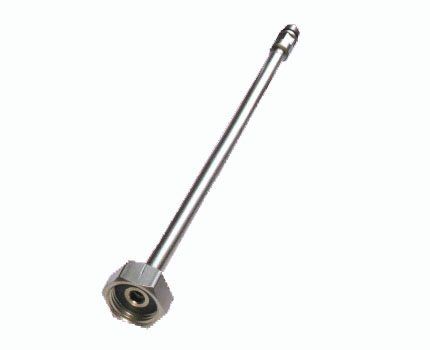
There can be several types of fastenings:
- Petal latch and fitting. To ensure a tight connection, simply insert the tube into the hole in the mixer until it clicks.
- Threaded connection. The tube simply screws into the tap.
- Push-in connector. It is a springy cylindrical sleeve, cut longitudinally on one side so that it forms 4 petals. When rotated, a special nut bends them towards the center. Thus, they firmly clamp the cylindrical part inside themselves.
For compact markings, the manufacturer specifies the type of end connection, such as g/g, g/w or w/w. This means that the product is fastened on both sides with a union nut, in the second case with a nut and a fitting, in the third with a fitting.
These clamps come in several union nut diameters:
- 1 inch;
- ½ inch;
- ¾ inch;
- 3/8 inch.
The fitting has a standard fastening size M10, which means the diameter is in mm. It can be standard or extended in length.
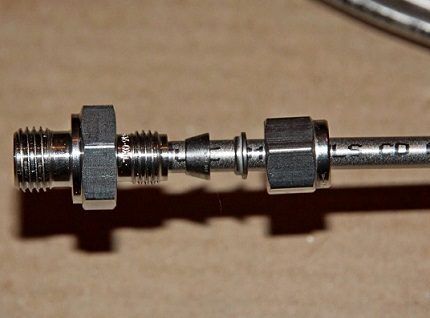
Types of manufacturing materials
Another classification is the division according to the metal used.
Tubes can be:
- Steel. Very durable galvanized pipes prevent corrosion and have low temperature expansion.
- Copper. They do not rust, disinfect water, are plastic, and can withstand temperatures up to 250 °C.
- Brass. They have high thermal conductivity, can withstand pressure up to 400 atmospheres, easily tolerate temperatures up to 300 °C without harming the solder, and are not destroyed by the influence of chlorine.
If there is a need to bend the tube, you should use a special device - pipe bender. If you don’t have it at hand, you shouldn’t try to do it just like that, because the tube may lose its stability, changing its cylindrical shape at the point of rotation.
You can use a spring of suitable diameter that will fit inside the tube. The spiral must be strong and have frequent turns. Next, after heating the tube, you need to carefully bend it and remove the spring.

Another option is to seal the tube with sand. To do this, cover one side with a plug and pour it inside. After heating, you can bend it, but you should pour out the abrasive only after it has cooled, after which it is advisable to wash the structure.
Pros and cons of metal design
Despite the fact that flexible liner is used almost everywhere due to its simplicity, low cost and set of excellent characteristics, the use of the metal version is in sufficient demand.
This relatively expensive type of plumbing fixtures is fully justified by its quality.
The main advantages of metal include:
- interesting classic appearance;
- ability to withstand high temperatures, as well as temperature changes;
- resistance to harmful chemical influences;
- high strength;
- not susceptible to corrosion;
- service life up to 20 years.
The only disadvantages are the high price and difficulties when installing this type of water supply. Since the elements to be connected must be stationary during installation, assembly causes problems.
It is necessary to accurately measure the length of the tubes and change the direction of the water sockets if it is not in a vertical position. This will require special curved fitting. In addition, in the future, due to the fixed structure, maintenance and repair of cranes becomes more difficult.
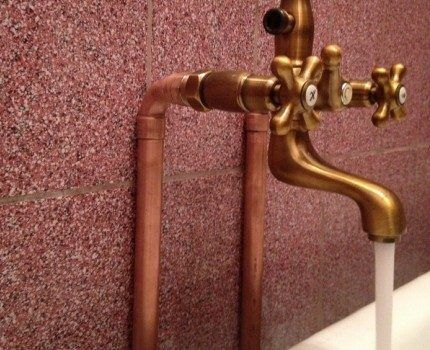
Features of installing metal liner
The long-term use of plumbing products depends not only on the correctly selected components, but also on the correct installation and compliance with all the nuances during installation:
- A strainer should be installed at the beginning of the plumbing system to prevent clogging of complex equipment.
- After bending the metal liner, it is necessary to clean the inside of it from possible chipped particles.
- Tightening the connecting elements is done carefully so as not to pinch the O-rings, violating the tightness.
- After tightening, you need to open the water and check for leaks after 15-20 minutes.
There are also some useful tips that will come in handy when carrying out installation work yourself. So, if you have to cut a tube, this is done with a hacksaw. But it is better not to use a pipe cutter for these purposes - it leaves dents.
As for the liner size 10, it can be bent without using a pipe bender or filling it with sand.
Conclusions and useful video on the topic
The video shows how to replace flexible faucet hoses with metal ones:
Despite the fact that, due to their low cost, practicality and ease of installation, in most cases flexible versions of the liners are chosen, the rigid version will always be in demand. This is due to its reliability and durability.
At high-risk facilities, in places with large and sudden pressure changes, for example, in basements and first floors of buildings, for trouble-free operation, preference is given to metal rigid connections. Such products are more expensive than flexible ones, but even their most budget options are superior in terms of price and quality.
Still have questions about the topic of the article? Or maybe you have valuable information that you can share with our readers? Please leave your comments, ask questions, and share your experience in the block below.




I don't trust flexible hoses at all. At night I heard the sound of water pouring from the bathroom; the flexible hose that connected the tank and the cold water supply pipe simply burst.The braid was metal, the sealed tube inside was torn. I was shocked, it’s good that I was at home. I never skimped on plumbing; the pipe did not last even six months. On the first day off, I replaced all the flexible hoses on the plumbing with rigid ones.
Probably the reason is a fistula; this happens regardless of the service life of the hoses. Or there was a water hammer. Most likely, the braid burst first, and then the filling broke, which became mobile. It’s unpleasant that this happened just six months later, but the flexible line itself is not bad, there is, for example, a bellows line, it is much stronger, there shouldn’t be any fistulas there.
Are there different types of eyeliners? We bought different mixers in stores and never paid attention to the connections to them. They delivered, delivered and simply installed. Never had any problems.